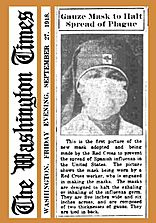Cloth face mask facts for kids
Quick facts for kids Cloth face mask |
|
|---|---|
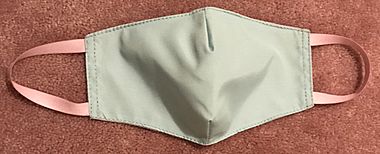
A cloth face mask made out of 2-ply construction with layers of 85% polyester and 15% cotton fabric
|
|
| Other names | Fabric mask |
| Specialty | {{#statements:P1995}} |
A cloth face mask is a type of mask made from common fabrics, like cotton. People wear it over their mouth and nose.
When stronger masks are not available, and when people cannot stay far apart, health groups suggest using cloth masks. They help stop sick people from spreading tiny drops that carry viruses when they breathe, cough, or sneeze. This is called "source control." Cloth masks are not as good as N95 masks or surgical masks at protecting the person wearing them. So, health groups do not call them "personal protective equipment." People use them at home and in public to help protect against sickness and small bits of air pollution.
Healthcare workers used cloth face masks from the late 1800s until the mid-1900s. In the 1960s, richer countries started using disposable surgical masks instead. These masks had special filters. But cloth masks were still used in poorer countries. During the COVID-19 pandemic, cloth masks became popular again in many places. This was because there were not enough other masks. People also liked them because they were better for the environment and easy to use.
Contents
What are cloth face masks used for?
Before the COVID-19 pandemic, reusable cloth face masks were mostly used by healthcare workers in developing countries. They were very common in Asia. Cloth masks are different from surgical masks and respirators like N95 masks. Surgical masks and respirators are made from special materials that are tested for how well they filter tiny particles.
In hospitals, sick patients wear cloth masks to help stop the spread of germs through respiratory droplets. Healthcare workers also use them if they cannot get surgical masks or respirators. Health experts say cloth masks should only be a last choice for healthcare workers. People also wear them in public to protect against sickness and air pollution. They help keep the wearer's breath from spreading viruses.
You can buy many kinds of cloth face masks. People can also make their own masks from things like bandanas, T-shirts, handkerchiefs, scarves, or towels. Some reusable cloth masks have filters inside. If they fit well, they can block particles almost as well as medical masks.
What do experts recommend?
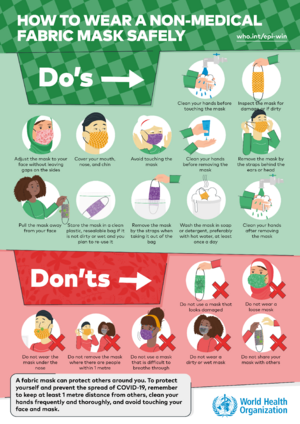
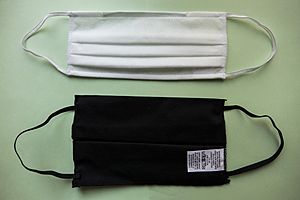
The World Health Organization (WHO) suggests wearing cloth face masks in public. This is important where people cannot keep a safe distance apart, to help stop the spread of coronavirus. They say wearing a mask is just one way to lower the risk of getting sick. The US Center for Disease Control, Johns Hopkins University School of Medicine, The Mayo Clinic, and Cleveland Clinic all agree with this advice. The WHO also recommends that people over 60 or those with health problems should wear medical masks in areas where the virus is spreading widely.
The WHO suggests using masks with at least three layers of different materials. Two layers of spunbond polypropylene are also thought to filter well and let you breathe easily. When making cloth masks, two things are important: how well the material filters and how easy it is to breathe through.
Experts often use a "Q" factor to measure how good a filter is. A higher "Q" value means better performance. Experts recommend a Q-factor of three or higher for masks.
Research suggests that 2 to 4 layers of plain cotton or flannel work best. These fabrics should have at least 100 thread count.
| Material | Type | How well it filters (starts) (%) | How hard it is to breathe through (Pa) | Filter quality factor, Q (kPa−1) |
|---|---|---|---|---|
| Polypropylene | spunbond | 6 | 1.6 | 16.9 |
| Cotton (sweater) | knit | 26 | 17 | 7.6 |
| Cotton (T-shirt) | knit | 21 | 14.5 | 7.4 |
| Polyester | knit | 17 | 12.3 | 6.8 |
| Cotton (T-shirt) | woven | 5 | 4.5 | 5.4 |
| Cellulose (tissue paper) | bonded | 20 | 19 | 5.1 |
| Cellulose (paper towel) | bonded | 10 | 11 | 4.3 |
| Silk (napkin) | woven | 4 | 7.3 | 2.8 |
| Cotton (handkerchief) | woven | 1.1 | 9.8 | 0.48 |
| Cotton, gauze | woven | 0.7 | 6.5 | 0.47 |
| Nylon | woven | 23 | 244 | 0.4 |
How well do they work?
Cloth face masks can help stop sick people from spreading germs. This is called "source control." But they are not usually considered personal protective equipment for the wearer. This is because they often do not filter very well. There are no official rules for homemade cloth face masks.
As of 2015, there had not been many big studies on reusable cloth face masks. Most research was done a long time ago, before disposable surgical masks were common. One study in 2010 found that 40–90% of tiny particles could get through a cloth mask. How well a cloth mask works depends a lot on its shape, how well it fits, and the type and number of fabric layers.
The main job of masks worn by the public is to "stop those who are already infected from spreading the virus." This was very important during the COVID-19 pandemic. Many people with COVID-19 did not show symptoms but could still spread the virus. For example, on the Diamond Princess cruise ship, 634 people got infected. About half of them had no symptoms when tested. It is good to remember that people who wear masks often also wash their hands and keep a safe distance. Using many ways to prevent sickness, like the Swiss cheese model, is the best approach.
Compared to people not wearing masks, a mask made of muslin and flannel greatly reduced bacteria found in the air. It cut down bacteria on plates by 99% and airborne germs by 99%. It also reduced bacteria in tiny air particles by 88% to 99%. In 1975, scientists compared medical masks and a reusable cloth mask. Both filtered bacteria very well (96% to 99%). For tiny air particles, the cloth mask filtered 89%, while medical masks filtered 72% to 89%.
In 2013, Public Health England did an experiment. A surgical mask filtered 90% of virus particles from coughs. A vacuum cleaner bag filtered 86%, a tea towel 72%, and a cotton t-shirt 51%. But it is very important that any homemade mask fits well and seals around the mouth and nose. Using different layers, tight weaves, and mixed fabrics can make masks filter better. Cotton is a common material. Masks can filter over 80% of tiny particles if they combine fabrics like cotton-silk, cotton-chiffon, or cotton-flannel. The best cloth masks need at least three layers. The inner layer should be cotton to soak up moisture. The outer layers should be water-resistant, like polyester. Masks should be cleaned after each use. You can wash them in hot, soapy water and dry them with high heat.
A brief history of masks
Long ago, in Roman times, Pliny the Elder suggested miners use animal bladders to avoid breathing in lead dust. Some followers of Jainism in India, around 500 B.C.E., wear cloth masks. This helps them avoid accidentally breathing in insects, which is part of their practice of ahimsa. In the 1500s, Leonardo da Vinci advised using a wet cloth to protect against harmful chemicals. Later, the plague doctor costume included a mask with a beak. This was thought to protect against infectious "bad air."
In the American West, cowboys often wore bandannas. These could protect their faces from dust. They could also hide their identity.
In 1890, William Stewart Halsted started using rubber gloves and surgical face masks. Other European surgeons had used cotton gloves and masks earlier. These masks became common after World War I and the Spanish flu epidemic of 1918. Wu Lien-teh promoted cloth face masks during the Manchurian plague in 1910–11.
Modern surgical masks, made of special fabric, mostly replaced cloth masks in the 1960s. But cloth masks continued to be used in developing countries. They were used in Asia during the 2002–2004 SARS outbreak. They were also used in West Africa during the 2013–2016 Ebola epidemic.
Masks during the COVID-19 pandemic
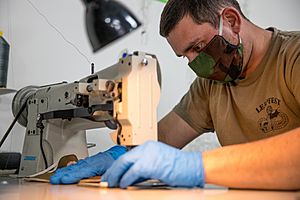
During the COVID-19 pandemic, most countries suggested using cloth masks. This helped slow the spread of the virus.
On June 5, 2020, the WHO changed its advice. It recommended that the public should wear fabric masks where COVID-19 was spreading widely and people could not keep a safe distance. This included places like public transport, shops, or crowded areas.
See also
 In Spanish: Mascarilla higiénica para niños
In Spanish: Mascarilla higiénica para niños
- Nose filter
Images for kids
-
Infographic from the World Health Organization showing the do's and don'ts of wearing a fabric mask to prevent the spread of COVID-19
-
Two French cloth masks certified by AFNOR. The white mask is made of polypropylene and the black one is made of cotton.
-
During the 1918 flu pandemic, a streetcar conductor in Seattle refuses a person who attempts to board without wearing a mask.
-
Rhode Island National Guardsmen sew face masks during the COVID-19 pandemic, April 6, 2020.


